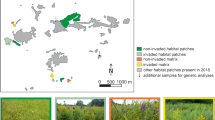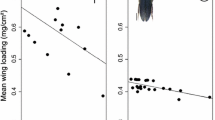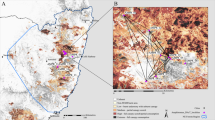Abstract
Spatial configuration of habitats influences genetic structure and population fitness whereas it affects mainly species with limited dispersal ability. To reveal how habitat fragmentation determines dispersal and dispersal-related morphology in a ground-dispersing insect species we used a bush-cricket (Pholidoptera griseoaptera) which is associated with forest-edge habitat. We analysed spatial genetic patterns together with variability of the phenotype in two forested landscapes with different levels of fragmentation. While spatial configuration of forest habitats did not negatively affect genetic characteristics related to the fitness of sampled populations, genetic differentiation was found higher among populations from an extensive forest. Compared to an agricultural matrix between forest patches, the matrix of extensive forest had lower permeability and posed barriers for the dispersal of this species. Landscape configuration significantly affected also morphological traits that are supposed to account for species dispersal potential; individuals from fragmented forest patches had longer hind femurs and a higher femur to pronotum ratio. This result suggests that selection pressure act differently on populations from both landscape types since dispersal-related morphology was related to the level of habitat fragmentation. Thus observed patterns may be explained as plastic according to the level of landscape configuration; while anthropogenic fragmentation of habitats for this species can lead to homogenization of spatial genetic structure.


Similar content being viewed by others
References
Anderson CD, Epperson BK, Fortin MJ, Holderegger R, James PMA, Rosenberg MS, Scribner KT, Spear S (2010) Considering spatial and temporal scale in landscape-genetic studies of gene flow. Mol Ecol 19:3565–3575
Arens P, Wernke-Lenting JH, Diekötter T, Rothenbühler C, Speelmans M, Hendrickx F, Smulders MJM (2005) Isolation and characterization of microsatellite loci in the dark bush cricket, Pholidoptera griseoaptera (Tettigoniidae). Mol Ecol Notes 5:413–415
Belkhir K, Borsa P, Chikhi L, Raufaste N, Bonhomme F (2004) GENETIX 4.05, logiciel sous Windows TM pour la génétique des populations. Laboratoire Génome, Populations, Interactions, Université de Montpellier II, Montpellier
Belovsky GE, Slade JB (1993) The role of vertebrate and invertebrate predators in a grasshopper community. Oikos 68:193–201
Berggren Å, Carlson A, Kindvall O (2001) The effect of landscape composition on colonization success, growth rate and dispersal in introduced bush-crickets Metrioptera roeseli. J Anim Ecol 70:663–670
Berggren Å, Birath B, Kindvall O (2002) Effect of corridors and habitat edges on dispersal behavior, movement rates, and movement angles in Roesel’s bush-cricket (Metrioptera roeseli). Conserv Biol 16:1562–1569
Berteaux D, Réale D, McAdam AG, Boutin S (2004) Keeping pace with fast climate change: can arctic life count on evolution? Integr Comp Biol 44:140–151
Bonte D, Hovestadt T, Poethke HJ (2010) Evolution of dispersal polymorphism and local adaptation of dispersal distance in spatially structured landscapes. Oikos 119:560–566
Bonte D, van Dyck H, Bullock JM, Coulon A, Delgado M, Gibbs M, Lehouck V, Matthysen E, Mustin K, Saastamoinen M, Schtickzelle N, Stevens VM, Vandewoestijne S, Baguette M, Barton K, Benton TG, Chaput-Bardy A, Clobert J, Dytham C, Hovestadt T, Meier CM, Palmer SCF, Turlure C, Travis JMJ (2011) Costs of dispersal. Biol Rev doi. doi:10.1111/j.1469-185X.2011.00201.x
Bowler DE, Benton TG (2005) Causes and consequences of animal dispersal strategies: relating individual behaviour to spatial dynamics. Biol Rev 80:205–225
Brouwers NC, Newton AC (2009) The influence of habitat availability and landscape structure on the distribution of wood cricket (Nemobius sylvestris) on the Isle of Wight, UK. Landscape Ecol 24:199–212
Brouwers NC, Newton AC (2010) The influence of barriers and orientation on the dispersal ability of wood cricket (Nemobius sylvestris) (Orthoptera: Gryllidae). J Insect Conserv 14:313–317
Brouwers NC, Newton AC, Bailey S (2011) The dispersal ability of wood cricket (Nemobius sylvestris) (Orthoptera: Gryllidae) in a wooded landscape. Eur J Entomol 108:117–125
Burrows M, Morris O (2003) Jumping and kicking in bush crickets. J Exp Biol 206:1035–1049
Chapuis MP, Estoup A (2007) Microsatellite null alleles and estimation of population differentiation. Mol Biol Evol 24:621–631
Chevin L-M, Lande R (2011) Adaptation to marginal habitats by evolution of increased phenotypic plasticity. J Evol Biol 24:1462–1476
Chybicki IJ, Burczyk J (2009) Simultaneous estimation of null alleles and inbreeding coefficients. J Hered 100:106–113
Crawford NG (2010) SMOGD: software for the measurement of genetic diversity. Mol Ecol Res 10:556–557
Detzel P (1998) Die Heuschrecken Baden Württembergs. Verlag Eugen Ulmer GmbH & Co, Stuttgart
DeWitt TJ, Scheiner SM (2004) Phenotypic plasticity. Functional and conceptual approaches. Oxford University Press, New York, NY
Diekötter T, Csencsics D, Rothenbühler C, Billeter R, Edwards PJ (2005) Movement and dispersal patterns in the bush cricket Pholidoptera griseoaptera: the role of developmental stage and sex. Ecol Entomol 30:419–427
Diekötter T, Speelmans M, Dusoulier F, Van Wingerden WKRE, Malfait JP, Crist TO, Edwards PJ, Dietz H (2007) Effects of landscape structure on movement patterns of the flightless bush cricket Pholidoptera griseoaptera. Environ Entomol 36:90–98
Diekötter T, Baveco H, Arens P, Rothenbühler C, Billeter R, Csencsics D, De Filippi R, Hendrickx F, Speelmans M, Opdam P, Smulders MJM (2010) Patterns of habitat occupancy, genetic variation and predicted movement of a flightless bush cricket, Pholidoptera griseoaptera, in an agricultural mosaic landscape. Landscape Ecol 25:449–461
Girvetz EH, Thorne JH, Berry AM, Jaeger JAG (2008) Integration of landscape fragmentation analysis into regional planning: a statewide multi-scale case study from California, USA. Landscape Urban Plann 86:205–218
Goudet J (1995) FSTAT (vers. 1.2): a computer program to calculate F-statistics. J Hered 86:85–486
Guido M, Gianelle D (2001) Distribution patterns of four Orthoptera species in relation to microhabitat heterogeneity in an ecotonal area. Acta Oecol 22:175–185
Hanski I, Eralahti C, Kankare M, Ovaskainen O, Siren H (2004) Variation in migration propensity among individuals maintained by landscape structure. Ecol Lett 7:958–966
Heidinger IMM, Hein S, Bonte D (2010) Patch connectivity and sand dynamics affect dispersal-related morphology of the blue-winged grasshopper Oedipoda caerulescens in coastal grey dunes. Insect Cons Divers 3:205–212
Hein S, Gombert J, Hovestadt T, Poethke H-J (2003) Movement patterns of the bush cricket Platycleis albopunctata in different types of habitat: matrix is not always matrix. Ecol Entomol 28:432–438
Holzhauer SIJ, Ekschmitt K, Sander AC, Dauber J, Wolters V (2006) Effect of historic landscape change on the genetic structure of the bush-cricket Metrioptera roeseli. Landscape Ecol 21:891–899
Humbert JY, Ghazoul J, Richner N, Walter T (2010) Hay harvesting causes high orthopteran mortality. Agri Ecosys Enviro 139:522–527
Jaquiéry J, Broquet T, Hirzel AH, Yearsley J, Perrin N (2011) Inferring landscape effects on dispersal from genetic distances: how far can we go? Mol Ecol 20:692–705
Jordan F, Baldi A, Orci KM, Racz I, Varga Z (2003) Characterizing the importance of habitat patches and corridors in maintaining the landscape connectivity of a Pholidoptera transsylvanica (Orthoptera) metapopulation. Landscape Ecol 18:83–92
Jost L (2008) G ST and its relatives do not measure differentiation. Mol Ecol 17:4015–4026
Keller I, Nentwig W, Largiader CR (2004) Recent habitat fragmentation due to roads can lead to significant genetic differentiation in an abundant flightless ground beetle. Mol Ecol 13:2983–2994
Kindvall O (1999) Dispersal in a metapopulation of the bush cricket, Metrioptera bicolor (Orthoptera: Tettigoniidae). J Anim Ecol 68:172–185
Kindvall O, Petersson A (2000) Consequences of modelling interpatch migration as a function of patch geometry when predicting metapopulation extinction risk. Ecol Model 129:101–109
Lange R, Durka W, Holzhauer SIJ, Wolters V, Diekötter T (2010) Differential threshold effects of habitat fragmentation on gene flow in two widespread species of bush crickets. Mol Ecol 19:4936–4948
Maas S, Detzel P, Staudt A (2002) Gefährdungsanalyse der Heuschrecken Deutschlands. Verbreitungsatlas, Gefährdungseinstufung und Schutzkonzepte. Bundesamt für Naturschutz, Bonn-Bad Godesberg
Manni F, Guérard E, Heyer E (2004) Geographic patterns of (genetic, morphologic, linguistic) variation: how barriers can be detected by “Monmonier’s algorithm”. Hum Biol 76:173–190
Marini L, Fontana P, Scotton M, Klimek S (2008) Vascular plant and Orthoptera diversity in relation to grassland management and landscape composition in the European Alps. J Appl Ecol 45:361–370
McGarigal K, Cushman SA, Neel MC, Ene E (2002) FRAGSTATS: Spatial pattern analysis program for categorical maps. University of Massachusetts, Amherst
Moser B, Jaeger JAG, Tappeiner U, Tasser E, Eiselt B (2007) Modification of the effective mesh size for measuring landscape fragmentation to solve the boundary problem. Landscape Ecol 22:447–459
Mousseau TA, Roff DA (1989) Adaptation to seasonality in a cricket: patterns of phenotypic and genotypic variation in body size and diapause expression along a cline in season length. Evolution 43:1483–1496
Ortego J, Aguirre MP, Cordero PJ (2012) Genetic and morphological divergence at different spatiotemporal scales in the grasshopper Mioscirtus wagneri (Orthoptera: Acrididae). J Insect Conserv 16:103–110
Poniatowski D, Fartmann T (2009) Experimental evidence for density-determined wing dimorphism in two bush-crickets (Ensifera: Tettigoniidae). Eur J Entomol 106:599–605
Poniatowski D, Fartmann T (2010) What determines the distribution of a flightless bush-cricket (Metrioptera brachyptera) in a fragmented landscape? J Insect Cons 14:637–645
Prevedello JA, Vieira MV (2010) Does the type of matrix matter? A quantitative review of the evidence. Biodiv Conserv 19:1205–1223
R Development Core Team (2008) R: A language and environment for statistical computing. R Foundation for Statistical Computing, Vienna
Ranius T (2006) Measuring the dispersal of saproxylic insects: a key characteristic for their conservation. Popul Ecol 48:177–188
Reinhardt K, Köhler G, Maas S, Detzel P (2005) Low dispersal ability and habitat specificity promote extinctions in rare but not in widespread species: the Orthoptera of Germany. Ecography 28:593–602
Reinhold K (1994) Inheritance of body and testis size in the bushcricket Poecilimon veluchianus Ramme (Orthoptera; Tettigoniidae) examined by means of subspecies hybrids. Biol J Linn Soc 52:305–316
Ricketts TH (2001) The matrix matters: effective isolation in fragmented landscapes. Am Nat 158:87–99
Ronce O (2007) How does it feel to be like a rolling stone? Ten questions about dispersal evolution. Annu Rev Ecol Evol Syst 38:231–253
Storfer A, Murphy MA, Spear SF, Holderegger R, Waits LP (2010) Landscape genetics: where are we now? Mol Ecol 19:3496–3514
Szulkin M, Bierne N, David P (2010) Heterozygosity-fitness correlations: a time for reappraisal. Evolution 64:1202–1217
Thomas CD (2000) Dispersal and extinction in fragmented landscapes. Proc R Soc Lond B 267:139–145
Van Dyck H, Baguette M (2005) Dispersal behaviour in fragmented landscapes: routine or special movements? Basic Apl Ecol 6:535–545
van Oosterhout C, Hutchinson W, Wills D, Shipley P (2004) Micro-checker: software for identifying and correcting genotyping errors in microsatellite data. Mol Ecol Notes 4:535–538
Vandewoestijne S, Schtickzelle N, Baguette M (2008) Positive correlation between genetic diversity and fitness in a large, well-connected metapopulation. BMC Biol 6:46
Walsh S, Metzger D, Higuchi R (1991) Chelex 100 as a medium for simple extraction of DNA for PCR-based typing from forensic material. Biotechniques 10:506–513
Weir BS, Cockerham CC (1984) Estimating F-statistics for the analysis of population structure. Evolution 38:1358–1370
Whitman DW (2008) The significance of body size in the Orthoptera: a review. J Orthop Res 17:117–134
Whitman DW, Ananthakrishnan TN (2009) Phenotypic plasticity in insects. Mechanisms and consequences. Science Publishers, Enfield
Zar JH (1999) Biostatistical Analysis. Prentice Hall, NJ
Acknowledgments
We are deeply grateful to two anonymous reviewers for their extensive and useful comments on an earlier version of the manuscript. This work was funded by Slovak Research and Development Agency (APVV-0497-10) and Slovak Scientific Grant Agency (VEGA 2/0157/11).
Author information
Authors and Affiliations
Corresponding author
Electronic supplementary material
Below is the link to the electronic supplementary material.
Rights and permissions
About this article
Cite this article
Kaňuch, P., Jarčuška, B., Schlosserová, D. et al. Landscape configuration determines gene flow and phenotype in a flightless forest-edge ground-dwelling bush-cricket, Pholidoptera griseoaptera . Evol Ecol 26, 1331–1343 (2012). https://doi.org/10.1007/s10682-012-9571-5
Received:
Accepted:
Published:
Issue Date:
DOI: https://doi.org/10.1007/s10682-012-9571-5




